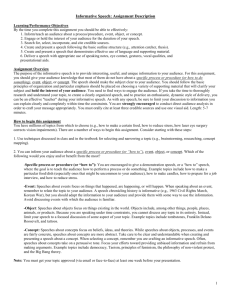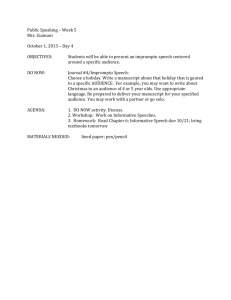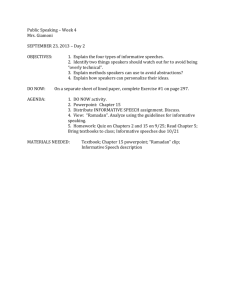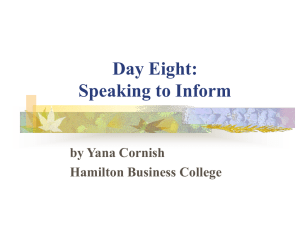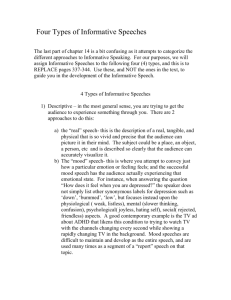Speaking to Inform
advertisement
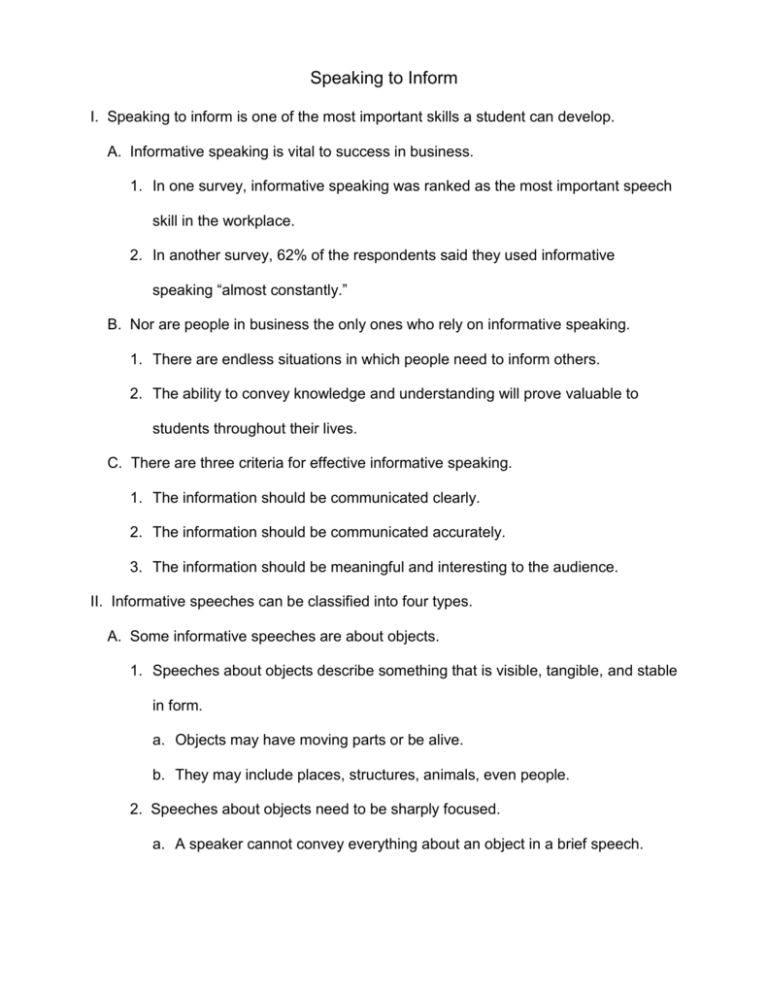
Speaking to Inform I. Speaking to inform is one of the most important skills a student can develop. A. Informative speaking is vital to success in business. 1. In one survey, informative speaking was ranked as the most important speech skill in the workplace. 2. In another survey, 62% of the respondents said they used informative speaking “almost constantly.” B. Nor are people in business the only ones who rely on informative speaking. 1. There are endless situations in which people need to inform others. 2. The ability to convey knowledge and understanding will prove valuable to students throughout their lives. C. There are three criteria for effective informative speaking. 1. The information should be communicated clearly. 2. The information should be communicated accurately. 3. The information should be meaningful and interesting to the audience. II. Informative speeches can be classified into four types. A. Some informative speeches are about objects. 1. Speeches about objects describe something that is visible, tangible, and stable in form. a. Objects may have moving parts or be alive. b. They may include places, structures, animals, even people. 2. Speeches about objects need to be sharply focused. a. A speaker cannot convey everything about an object in a brief speech. b. It is important to choose a specific purpose that is not too broad to be achieved in the allotted time. 3. Speeches about objects can use a variety of organizational patterns. a. A speech about the history or evolution of an object would be arranged in chronological order. b. A speech about the main features of an object might be arranged in spatial order. c. Most informative speeches about objects will fall into topical order. B. Some informative speeches are about processes. 1. A process is a systematic series of actions that lead to a specific result or product. 2. Speeches about processes explain how something is made, describe how something is done, or convey how something works. 3. There are two kinds of informative speeches about processes. a. One type explains a process so the audience will understand it better. b. The other type explains a process so the audience will be able to perform the process themselves. 4. Speeches about processes often require visual aids. a. Charts are an effective way to outline the steps of a process. b. In some cases, the speaker will need to demonstrate the steps or techniques of the process. 5. Speeches about processes require careful organization. a. Speeches that explain a process step by step are arranged in chronological order. b. Speeches that focus on the major principles or techniques involved in performing the process are usually arranged in topical order. c. Whichever method of organization is used, each step in the process must be clear and easy for the listeners to follow. C. Some informative speeches are about events. 1. Speeches about events can deal with any kind of happening or occurrence. a. The occurrence may be historical in nature – such as the Battle of Little Big Horn or the civil rights movement. b. The occurrence may be in everyday nature – such as modern dance or chronic fatigue syndrome. 2. There are many ways to organize a speech about an event. a. Speeches that recount the history of an event are arranged in chronological order. b. Speeches that analyze the causes and effects of an event are arranged in casual order. c. Speeches that deal with particular elements of an event are usually arranged in topical order. D. Some informative speeches are about concepts. 1. Speeches about concepts convey information concerning beliefs, theories, principles, or other abstract subjects. 2. Speeches about concepts are usually arranged in topical order. a. One common approach is to enumerate the main features or aspects of the concept. b. A more complex approach is to define the concept, identify its major elements, and illustrate it with specific examples. c. Yet another approach is to explain competing schools of thought about the concept. 3. Speeches about concepts are often more complex than other kinds of informative speeches. a. When discussing concepts, a speaker should avoid technical language and define terms clearly. b. A speaker should also use examples and comparisons to make concepts understandable to listeners. E. The lines dividing speeches about objects, processes, events, and concepts are not absolute. 1. Most topics can fit into more than one category depending on how the speech is developed. 2. The most important thing is that speakers decide how they want to handle a topic and then develop the speech accordingly. III. There are five guidelines for effective informative speaking. A. Informative speakers should be wary of overestimating what the audience knows. 1. In most cases, the audience will be only vaguely knowledgeable about the speaker’s topic. 2. The speaker cannot assume the audience will know what he or she means. 3. To avoid misunderstanding, the speaker must explain ideas thoroughly and clearly. 4. One way to do this is to consider whether the speech will be clear to someone who is hearing about the topic for the first time. 5. Informative speakers should keep in mind the journalists’ code: “Never overestimate the knowledge of your audience; never underestimate the intelligence of your audience.” B. Informative speakers should find ways to relate the subject directly to the audience. 1. Informative speakers must recognize that what is fascinating to them may not be fascinating to everybody. 2. Effective informative speakers work to get the audience interested – and to keep them interested. a. They begin with a creative introduction that connects the topic with interests and concerns of the audience. b. They find way throughout the body of the speech to talk about the topic in terms of their listeners. C. Informative speakers should avoid being too technical. 1. An informative speech may be overly technical because the subject matter is too specialized for the audience. 2. An informative speech may also be overly technical because of the speaker’s use of jargon or obscure language. 3. Effective informative speakers select topics that are not too technical for the audience. 4. Effective informative speakers recognize that language appropriate for an audience of specialists may well be confusing to a general audience. D. Informative speakers should avoid abstractions. 1. Replacing tedious abstractions with specific details makes an informative speech more compelling. 2. One way to avoid abstractions is through description. a. Colorful descriptions of external events can draw listeners into the speech. b. Description can also be used to communicate internal feelings vividly and engagingly. 3. A second way to avoid abstractions is with comparisons. a. Comparisons allow a speaker to explain new ides in concrete, familiar terms. b. Effective informative speakers are adept at using comparisons to draw listeners in to the speech. 4. A third way to avoid abstractions is with contrast. a. Like comparisons, contrast can put abstraction into concrete terms. b. Contrast is also an excellent way to give listeners a sense of perspective on concepts and events. E. Informative speakers should personalize their ideas. 1. Nothing enlivens an informative speech more than personal illustrations. 2. Whenever possible, informative speakers should try to dramatize their ideas in human terms. 3. The best way to accomplish this is with examples – real or hypothetical – that personalize the subject matter. Exercises for Critical Thinking 1. Below is a list of subjects for informative speeches. Your task is two-fold: (1) Select four of the topics and prepare a specific purpose statement for an informative speech about each of the four. Make sure that your four specific purpose statements include at least one that deals with its topic as an object, one that deals with its topic as a process, one that deals with its topic as an event, and one that deals with its topic as a concept. (2) Explain what method of organization you would most likely use in structuring a speech about each of your specific purpose statements. computers sports animals music science cultural customs education technology television hobbies Discussion: This example gets students to work on developing specific purpose statements for informative speeches. It also leads them to apply what is said in the text about methods of organizing informative speeches. If you include Chapter 4, “Selecting a Topic and Purpose,” or Chapter 8. “Organizing the Body of the Speech,” in the unit on informative speaking, you may wish to forego this exercise in favor of the exercises in Chapters 4 and 8.


